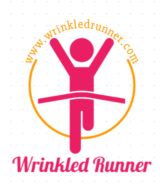
The Runners Stride
One of the things that has surprised me as I’ve learned more about running is the idea that our stride doesn’t have to be stretching our legs far out in front of us.
My vision of “good running” was always someone with really long legs stretching them out and covering a lot of ground quickly. I figured my short legs would never be great at running.
Stride Length
One of the best definitions of stride length I’ve seen, was given by Robert Maschi in a Runners World article (note that Runners World has a pay wall, so you may not be able to access this article). He is the leader of Drexel Universities Running Performance and Research Center.
He said stride length is the “distance covered between the spot where one foot hits the ground and then next time the SAME foot hits the ground again”.
Based on studies, the stride length you have now is probably most efficient for you and your body.
However, if you OVERSTRIDE or your CADENCE is under 160, you may want to look at improving your stride.
The other issue that may clue you in that you are overstriding is if you have knee issues.
Overstriding?
If your foot is landing in front of your center of gravity, which is in your core, you are over-striding and that can actually slow you down.
Usually a runner who is stretching their leg out in front of them will heel-strike, which can contribute to “hitting the brakes”. Only for a second, but that impacts your speed and running efficiency.
It can also cause issues like shin splints. You’re basically jolting your leg, and even though it is only for a short period of time, if you keep doing it over and over it does impact your body.
I’m usually pretty relaxed when it comes to running form. I think if you aren’t having injuries, and you are happy with what you are doing as a runner, you should run how you run.
There is definitely an argument if you are an elite or competitive runner, but for most of us…we are runners because we love it and/or it is our form of exercise.
I am, though, interested in improving where I can and I have been trying to be more aware of my strides to make my running more efficient.
I am finding when I am more aware of my strides and try to get my foot to land under my body, my cadence goes up and my pace gets faster.
There are all kinds of debates surrounding strides, cadence, etc. but this is what I am observing in me.
My last speed repeat workout proved to me that focusing on landing my foot under my hips boosts my speed. At one point I was hitting a 5:50 pace, which for me is really good.
Drills for Overstriding
When we are on a run, it can be hard to have to think about all the things we are trying to focus on.
Most of my runs are with Dave (the hubs), so we are generally talking and solving all the world’s problems instead of “fixing” any running mechanics.
I do one run a week solo, and that is about the only time I really hone in on my individual running.
So that is when I have been focused on striding and cadence. Some drills I do while on the run:
On my rest days from running, I hit the home gym and include things that will enhance my running.
These drills are a part of that:
Checking for Overstriding
One of the first things I do when coaching someone is video them running from different angles.
This helps me in a variety of ways. One of the things I am checking for is overstriding.
To check yourself, have a friend video you as you run. If you are still in the air and your heel lands in front of you when you land, you are “putting on the brakes”. This is overstriding.
Correct this by concentrating on having your foot land under you with your hips hinged slightly forward and your knee slightly bent.
Cadence
There is a whole lot of info about cadence. Whatever your stand on that (if you have one), for myself, I am finding I am increasing my cadence when I focus on landing my foot underneath me and bending the knee a bit.
When my cadence is higher, my paces are faster.
So whatever the science, or opinion or debate there is surrounding all of that…for me a higher cadence means a faster run.
I covered a lot about cadence here, so I won’t rehash it all.
If you have a way to check your cadence (basically if you have a running watch) and it’s less than 160 (steps per minute) you may want to increase your cadence.
The Runners Dance
Stride, Cadence and Pace all go together.
This YouTube video talks about the runners dance of all 3.
For myself, I have found that trying to up my cadence and be mindful of my stride has made me a better and faster runner.




